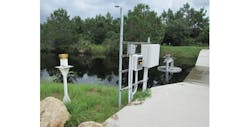Streamlining Storm Water Management Saves Time and Money
Like many municipalities in Florida, the City of Palm Coast is no stranger to hurricanes and tropical storms. These storms present danger to the water supply and crews that have to prepare canals for heavy rainfall.
The storm water division of Palm Coast has plenty of tasks to complete in preparation for a hurricane. Historically, one of those tasks was to remove stop logs from canal control structures. Removing these logs allowed the canals to drain, making room for the anticipated rainfall, but required crews to go out in dangerous conditions. In the past several years, Palm Coast added electrically actuated gates to many structures in order to remotely control the canals based on projected rainfall.
Solution
Palm Coast found an effective, economical solution—the Mission Communications managed SCADA system. The system allows the utility to remotely monitor canal water levels and control its new electrically actuated gates before, during and after tropical storms and hurricanes without putting crews at risk. The system offers Palm Coast officials complete oversight, even in inclement weather.
Results
Several canal control structures are equipped with remote terminal units (RTUs) and option boards. Mike Brennan, storm water manager for the city of Palm Coast, is able to remotely control the electrically actuated gates via analog outputs. Pulse inputs provide rainfall data that can be compared with rising water levels. Brennan uses this information to track the rate of change. Decision-makers are able to see changing rainfall conditions so they can take corrective action if a storm changes direction.
“There have been a few instances where a tropical storm threatens the area but changes direction at the last minute,” said Brennan. “By that time, we would have already removed the stop logs from the control structures to drain the canals in preparation for a storm that isn’t going to hit the city. Then we would be left with dry canals and residents complaining about the lack of water in the canals.”
Rainfall data lets Brennan know when adjustments must be made. For example, if 2 to 3 in. of rain falls, he knows the gates need to be opened by a corresponding amount. If the storm switches direction, he is able to quickly close the gates to stop the flow of water.
“What used to take us three to four days now takes us a couple of minutes,” said Brennan. “We are able to control the water levels instantly without risking the safety of our employees.”
The Mission system also gives city officials the ability to closely monitor surface water levels within the canals and maintain a steady head pressure on the groundwater table.
“If water levels get too low, we are notified,” said Brennan.
The system saves the city time, money and water, and it gives city crews the ability to efficiently prepare for a storm.


